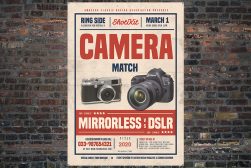
Differences between Canon 6d mark II vs 5d mark IV
Which camera is best between the Canon 6D Mark II vs Canon 5D Mark IV? This detailed comparison will help you choose which DSLR camera to buy.
If you’re trying to decide between the Canon EOS 6D Mark II and 5D Mark IV, this guide will show you the pros and cons of these two impressive DSLR cameras.
On the one hand, you have the Canon EOS 6D Mark II, a newer, cheaper, slightly flashier full-frame camera body from Canon.


Lightning-fast focusing, superior image quality and a professional build put the 5D Mark IV in top place.
But the Canon EOS 5D Mark IV, despite its age, is no slouch. And, as you’ll soon see, it’s a fantastic choice for professionals requiring a well-rounded camera body.
So if you want to know which of these Canon cameras is perfect for your needs (along with the nitty-gritty of why)… then keep reading.
Canon 5D Mark IV vs 6D Mark II| Key Differences
1. Size & Weight
While the 6D Mark II is hardly light (at 765 g/26.98 oz), the 5D Mark IV is about 100 grams heavier (at 890 g/31.39 oz).
This difference shouldn’t be too noticeable for most shooters, but you may start to feel the extra weight if you spend days with the 5D Mark IV in your hiking pack or if you’re the type who never leaves home without a camera.
What most photographers will notice, however, is the differences in size.
Both of these cameras are full-frame, which means that they’re far from small – but the 5D Mark IV is an all-around larger body, with a 151mm length (versus 144mm on the 6D Mark II), a 116mm thickness, thanks to a thicker handgrip (versus 111mm on the 6D Mark II), and a 76mm height (versus 75mm on the 6D Mark II).
These differences may not seem huge on paper, but the 5D Mark IV does feel like a bigger camera overall – see the full 5D Mark IV review for more images.

Live View double exposure | Canon EOS 5D Mark IV | © Jay Cassario
If you’re looking for a more travel-ready option, then the 6D Mark II is the better choice and the same is true for street photographers who need an unobtrusive full-frame body (though if you’re looking for unobtrusive, mirrorless is going to be your best bet).
Note that the larger handgrip on the 5D Mark IV does come with a handling advantage though I’ll discuss that in the next section.
2. Ergonomics & Handling
Both the Canon 6D Mark II and the Canon 5D Mark IV are successor cameras, which means that Canon has had time to iron out ergonomic kinks present in past bodies.
And it shows because both of these cameras are very refined in terms of button placing, overall feel, and useability.
Both offer a good number of buttons for advanced controls, though you do get a multi-controller type button on the 5D Mark IV.

Canon EOS 5D Mark IV | © Jay Cassario
In terms of handling: You’re going to feel good with either one in your hands, though as I mentioned in the previous section, the 5D Mark IV does have a bigger handgrip – and this allows for a slightly comfortable feeling overall.
By the way, part of the reasons both these cameras feel great in your hands is the build-quality. Neither one feels remotely plastic but instead operate as solid, weather-sealed bodies.
The 5D Mark IV is going to offer the more professional build overall; its magnesium alloy construction will hold up better than the 6D Mark II’s mix of aluminum alloy and polycarbonate. But both bodies are well-built and can withstand some bumps and bruises.
You’re also going to like the touchscreen options on both cameras which allow you to determine AF placement in Live View.
Note that the 5D Mark IV does offer two card slots: a CF slot and an SD slot, compared to the single SD slot on the 6D Mark II. For photographers who always need to produce two copies of their images, this is going to be a dealbreaker.
The one area where the 6D Mark II soundly beats the 5D Mark IV is in terms of the LCD handling: The rear screen is fully articulating, which means that you can twist it into odd angles for vlogging, architectural photography, macro photography, and much more.
3. Viewfinder & LCD
The Canon 6D Mark II is decent in terms of viewfinder and LCD performance, but nothing special. The 5D Mark IV, on the other hand, is firmly a professional camera and it has a viewfinder and LCD to go with that designation.
On the 6D Mark II, you get a standard 3” rear LCD, with 1040K dots. Compare this to the 3.2”, 1620K-dot LCD on the 5D Mark IV. It’s big, it’s sharp, and it looks incredible.

Flip out LCD Screen on Canon EOS 6D Mark II | © Stark Photography
You also get 100% viewfinder coverage on the 5D Mark IV which makes a huge difference for professionals who need to nail compositions in the field. The 6D Mark II only offers 98% coverage.
4. Autofocus and Drive
Neither the Canon 5D Mark IV nor the Canon 6D Mark II is really meant as an action camera, but neither one is a poor performer by any means.
The Canon 5D Mark IV, in particular, can handle wildlife and sports situations with confidence; it offers a nice, 61-point AF system (41 of which are cross-type points). This guarantees lightning-fast focusing on still subjects and does a pretty good job tracking moving subjects, as well.
You also get Canon’s Dual Pixel CMOS AF when shooting in Live View which guarantees quick focusing (and is further enhanced by the touch AF).

Canon EOS 6D Mark II | © Stark Photography
While the Canon EOS 6D Mark II also offers excellent Dual Pixel CMOS AF when using Live View, it struggles more than the 5D Mark IV in terms of shooting via the optical viewfinder.
The number of cross-type points is technically higher (45), but those are the 6D Mark II’s only AF points, and they’re bunched up around the center. So while focusing is far from slow, tracking doesn’t perform up to the standards of a serious action photographer.
The 5D Mark IV also manages to eke out a win in terms of continuous shooting speeds: You get 7 fps, compared to 6.5 fps on the 6D Mark II.
Neither spec is jaw-dropping, but 7 fps is going to be just enough for amateur action photographers.
Unfortunately, the 6D Mark II and 5D Mark IV could use some work in terms of their buffers: 19 RAW on the 5D Mark IV and 21 RAW on the 6D Mark II is far from impressive and is thoroughly trounced by modern mirrorless competitors.
5. Image Quality
With the exception of the Canon 5DS/5DS R pair, the Canon 6D Mark II and Canon 5D Mark IV are Canon’s two highest-resolution DSLRs:
The 6D Mark II packs 26.2 MP while the 5D Mark IV features 30.4 MP.
Both these megapixel counts are going to be enough for basically every amateur and should also be able to satisfy the needs of most professionals. But the 4 MP increase on the 5D Mark IV can make a slight difference when it comes to large, high-resolution printing, as well as cropping options.
In terms of high-ISO image quality, the RAW files on both cameras are pretty comparable. The 5D Mark IV has always been seen as Canon’s affordable low-light option for professionals, beating out cameras such as its predecessor (the 5D Mark III) and tying with the Nikon D750.

Canon EOS 5D Mark IV | © Jay Cassario
But while the Canon EOS 6D Mark II isn’t necessarily known for low-light shooting the way the 5D Mark IV is, looking at high-ISO RAWs side-by-side, I can see very little difference.
Both cameras hold up well until ISO 1600, where a small amount of noise becomes apparent. Images stay usable through ISO 6400, though I wouldn’t recommend ISO 12800 shots unless you’re ready to do a lot of post-processing or you don’t mind the noisy aesthetic.
Where the 5D Mark IV really separates itself from the 6D Mark II, however, is in terms of dynamic range (see guide).
The 5D Mark IV offers around 13+ stops of DR, which is decent for a full-frame, high-end camera body, but nothing impressive (and nowhere near the 14+ specs offered by Nikon and Sony).
However, the Canon 6D Mark II’s dynamic range performance is rather dismal, offering around 12 stops – which is worse than its predecessor, the original 6D.
For landscape photographers or anyone who’s frequently faced with HDR situations, the 6D Mark II just isn’t ideal.
6. Video
At the time of its release, the Canon 5D Mark IV offered good video capabilities: Cinema 4K up to 30p and 1080p video up to 60 fps.
Unfortunately, the DCI 4K video also came with a significant (1.6x) crop, which meant that wide-angle shooting is limited. These days, cropped 4K/30p is hardly impressive, especially with mirrorless models offering 4K/60p that use the full sensor.
But it’s better than the Canon EOS 6D Mark II which only allows for 1080p shooting up to 60 fps. Really, if video is a priority, neither one of these cameras is going to be a stellar choice – but the 5D Mark IV is by far the better option.
7. Price
At the time of writing, the Canon 5D Mark IV retails for around $2500 USD. This is significantly pricier than mirrorless competitors such as the Canon EOS R (at around $1800 USD) and the Sony a7 III (at around $2000 USD).
It’s also far more expensive than the Canon EOS 6D Mark II, which you can grab for just $1400 USD. So here’s the big question:
Is the Canon 5D Mark IV worth the extra $1000 USD? That depends on your needs.
In a lot of ways, the Canon 5D Mark IV functions as the big brother to the 6D Mark II. It offers better AF, more resolution, better image quality, an extra card slot, 4K video, and a better build.
For the serious landscape, wildlife, wedding, action, or product photographer, these differences can be huge, and can easily justify the additional $1000 USD.
But for the hobbyist looking for a first full-frame body, the cheaper 6D Mark II is going to be the much more tempting option. It comes with good AF, good image quality, and a good build – even if these capabilities can’t quite match up to the 5D Mark IV’s.
Plus, you get a fully-articulating touchscreen, which is essential for vloggers, and useful for pretty much everyone else.
Final Words

Canon EOS 5D Mark IV | © Jay Cassario
Both the Canon 5D Mark IV and the Canon 6D Mark II are excellent cameras and are sure to satisfy serious full-frame shooters.
That said, there are some key differences you’ll want to keep in mind:
The 5D Mark IV costs more – but it also offers some advantages over its smaller sibling, including 4K video, faster autofocus, faster continuous shooting, dual card slots, and better dynamic range.
Whereas the 6D Mark II comes at a great price, and for sub-$1500 USD (latest price here), you can get your hands on a body with top-notch image quality and ergonomics.
You also get a fully articulating touchscreen, which can be a big bonus for anyone looking to shoot videos (especially as part of a vlogging setup).
So which body is better?
In the end, it’s all about what’s right for you!


Lightning-fast focusing, superior image quality and a professional build put the 5D Mark IV in top place.














